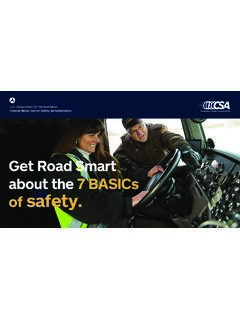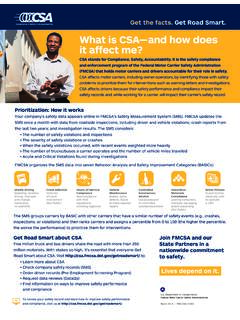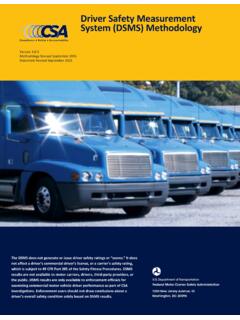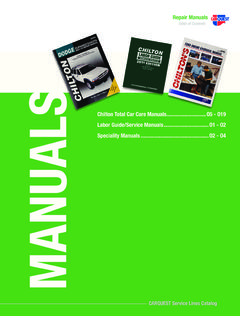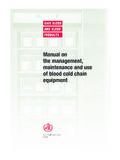Transcription of Safety Management Cycle for the Vehicle Maintenance BASIC ...
1 The SMC is a tool used by the Federal Motor Carrier Safety Administration (FMCSA) to help identify and address motor carrier Safety and compliance issues. Motor carriers can also use the SMC within their own businesses to determine which of the Safety Management Processes (SMPs) that they may need to improve by looking at the processes, Management , and controls associated with each Is the Safety Management Cycle (SMC)? Department of TransportationFederal Motor Carrier Safety Administration | JANUARY 2013 FMC-CSA-13-005 This document identifies tools motor carriers can use to establish and improve appropriate Safety Management controls, thereby reducing or eliminating violations. Motor carriers and drivers are reminded, however, that they are ultimately responsible for ensuring compliance with all applicable regulations. For information about the regulations related to the Vehicle Maintenance Behavior Analysis and Safety Improvement Category ( BASIC ) Inspection- repair - Maintenance , see the Vehicle Maintenance BASIC factsheet at Management Cycle for the Vehicle Maintenance BASIC Inspection- repair -MaintenancePolicies and procedures Develop a system of preventive Maintenance for compliant, safe, and efficient fleet operations, including a schedule for periodic Maintenance , inspection, and recordkeeping.
2 This system should be attuned to manufacturer recommendations, the carrier s own experience, and regulatory requirements. Develop a procedure ensuring that Vehicle defects that impact Safety and/or Safety compliance are reported, repaired, and certified before the Vehicle is operated. Develop procedures to ensure that Management is notified of Vehicle defects through the use of Driver Vehicle Inspection Records (DVIRS) and other communication channels, such as driver call-in and e-mail from mechanics. Develop a policy ensuring that drivers are qualified to complete thorough and timely DVIRs by the end of the day of the trip and prior to a subsequent assignment. Establish a policy requiring drivers to submit copies of all roadside inspections to carrier Management within 24 on page 2 Policies and and cation and and and Management CycleSTARTThe Safety Management Cycle , or SMC, consists of the six Safety Management Processes outlined in the graphic SMC is used to systematically assess SMPs in six areas: 1.
3 Policies and procedures , 2. Roles and Responsibilities, 3. Qualification and Hiring, 4. Training and Communication, 5. Monitoring and Tracking, and 6. Meaningful Action. By periodically reviewing each process, there is an opportunity to identify and correct breakdowns in SMPs before Safety and compliance issues are identified or crashes occur. The SMC can also be used after Safety and compliance issues or crashes have taken place to assist in determining which SMPs need attention. The SMCs for each BASIC can be found in the Information Center on the SMS Website at Department of TransportationFederal Motor Carrier Safety Administration2 | JANUARY 2013 FMC-CSA-13-005 Safety Management Cycle for the Vehicle Maintenance BASIC Inspection- repair -MaintenanceContinued on page 3 Continued from page 1 Develop policies and procedures requiring drivers to immediately notify appropriate Management of any roadside Vehicle Out-of-Service Order (OOSO).
4 Develop a written and progressive disciplinary policy focused on taking corrective action to ensure drivers comply with regulations and policies. A progressive disciplinary policy could include, among other things, written warnings, suspensions, or work restrictions, monetary penalties, and termination. This policy should also specify consequences for any carrier official who knowingly and willfully allows Vehicle Maintenance violations. Passenger Carrier Only: Develop systematic procedures for inspecting Maintenance items critical to fire Safety and emergency evacuation for example, checking wheel-hub lubrication levels according to the manufacturer s recommended inspection intervals, checking wheels for signs of excess heat every time the motorcoach is parked, regularly inspecting wiring and electrical systems for short circuits, and inspecting emergency exit operation and markings. Consider installation of fire detection and suppression systems on current fleets and as purchase options on new and Responsibilities Define and document responsibilities of managers, supervisors, drivers, dispatchers, mechanics, and technicians as related to Vehicle inspection, repair , and Maintenance policies, including the monitoring and documentation of defects and repairs.
5 Define and document roles and responsibilities of mechanics and technicians for differentiating between Safety -related defects and other defects and for taking unsafe vehicles out-of-service (OOS). Empower the person who is in charge of fixing trucks with the authority to complete tasks, such as the purchasing of new parts when needed. Define and document roles and responsibilities for checking daily completion of DVIRs and certifying repair before the next assignment. Define and document dispatcher responsibilities for planning, scheduling, monitoring, and adjusting fleet operations in accordance with repair and Maintenance requirements. Define driver responsibilities for informing managers, supervisors, and mechanics/technicians of Safety -related defects and repair requirements prior to Vehicle operation, including those resulting from Vehicle OOSOs. Passenger Carrier Only: Designate a manager to collect and evaluate all Vehicle inspection-, repair -, and Maintenance -related customer complaints and their Safety implications.
6 Qualification and Hiring Ensure that prospective employees are qualified to inspect, repair , and maintain the carrier s vehicles by querying applicants, checking with previous employers and references, and obtaining necessary documents regarding inspection, repair , and Maintenance responsibilities and (for mechanics and technicians) the quality of previous work, including whether Maintenance services were systematic and well documented. Create a detailed written record of each inquiry. Query the FMCSA information systems to check the Vehicle inspection, repair , and Maintenance performance (violations, OOS rates, etc.) of other carriers for whom the mechanic has worked. Then, ask follow-up questions to better determine the mechanics performance in those previous Department of TransportationFederal Motor Carrier Safety Administration3 | JANUARY 2013 FMC-CSA-13-005 Safety Management Cycle for the Vehicle Maintenance BASIC Inspection- repair -MaintenanceContinued from page 2 Continued on page 4 Verify prospective brake inspectors understanding of job requirements and their applicable training and apprenticeship credentials.
7 Screen prospective dispatchers for flexibility and the ability to deal with crisis by posing what if scenarios, such as how they would expedite an emergency repair or a replacement Vehicle if given an OOS call on a critical haul. Assess prospective drivers understanding of their responsibility for, and experience with, inspecting and maintaining the Vehicle , reporting defects, and verifying repairs. Ensure that the employment application captures all information required by Federal Motor Carrier Safety Regulations (FMCSRs) for example, for drivers, with regard to types of vehicles operated, and for mechanics and technicians, with regard to certification of the ability to perform repairs. Enhance the recruitment process to identify and attract qualified applicants for the positions of Safety director, mechanic, and other roles with responsibility for inspection, repair , and Maintenance , using outside resources such as insurance companies, industry groups, and consultants for employee searches and referrals.
8 Passenger Carrier Only: Verify that mechanics and technicians are familiar with advanced technology and are certified for the vehicles on which they will be and Communication Convey expectations to all applicable staff for adhering to Vehicle inspection, repairing, and Maintenance regulations and company policies and procedures , and for executing responsibilities by providing new hire and refresher training, and establish communication channels such as newsletters and/or meetings focused on conflicts between Vehicle availability and repair requirements. Ensure that all employees understand and accept their responsibility for timely communication of Safety issues related to fleet inspection, repair , and Maintenance to the appropriate individuals. Ensure that managers and supervisors articulate their commitment to and establish communication with employees concerning Vehicle inspection, repair , and Maintenance . Communicate the carrier s Vehicle Maintenance BASIC percentile to all staff and explain to them individually what they can do to help improve compliance.
9 Ensure that mechanics and technicians communicate with the Vehicle and equipment manufacturers and receive regular updated bulletins and recommendations. Ensure that carriers with non-English-speaking employees who need to communicate with English-speaking employees and to understand English language literature, such as the manufacturer s guide, have ways to deal successfully with language barriers. Ensure that all drivers, dispatchers, managers, mechanics, and technicians receive training, including methods and tools, and appropriate certifications to fulfill their responsibilities and documentation requirements regarding Vehicle inspection, repair , and Maintenance , as required by regulations and company policies. Implement and provide training for a fleet Maintenance software system that can be updated according to current industry and regulatory standards, manufacturer s recommendations, and the carrier s experience.
10 Train mechanics to be able to differentiate between Safety -related defects and other defects for example, by recognizing that defective wheel ends can lead to wheel separation. Department of TransportationFederal Motor Carrier Safety Administration4 | JANUARY 2013 FMC-CSA-13-005 Safety Management Cycle for the Vehicle Maintenance BASIC Inspection- repair - Maintenance Ensure that drivers are trained in Vehicle OOS rules, their responsibilities in adhering to them, and the carrier s procedures for reporting OOS violations and communicating appropriately with other personnel. Train all staff who are required to monitor and track Vehicle Maintenance on the appropriate company policies, including those related to discipline and incentives. Provide hiring officials with guidance on how best to attract, screen, and qualify applicants who are most likely to adhere to Vehicle inspection, repairing, and Maintenance regulations and company policies and procedures .
